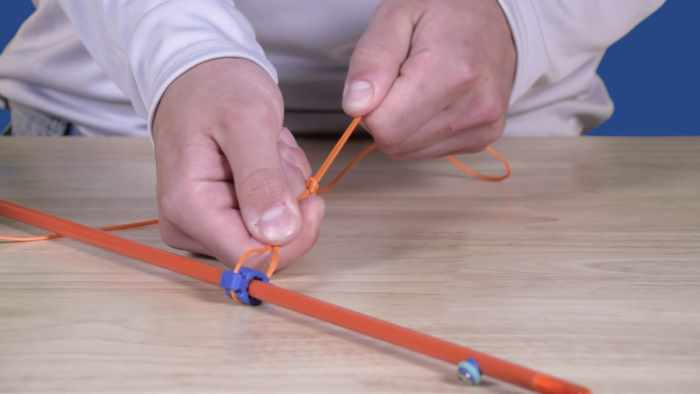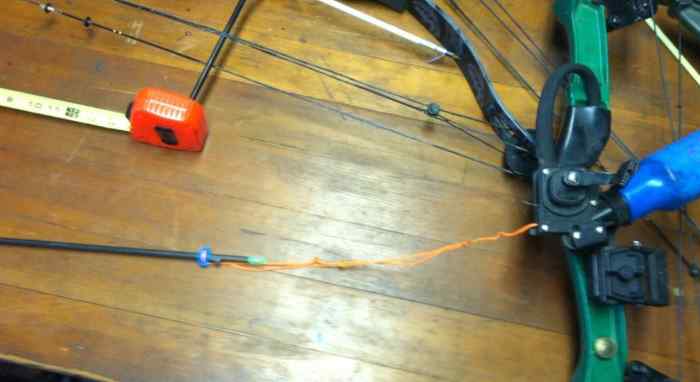Mastering the Shot: The Ultimate Guide to Tie a Bowfishing Arrow Slide (and Avoiding Snap-Back!)
Welcome to the exciting world of bowfishing – a mix of archery and hunting offering a unique challenge for outdoorsmen and women coupled with the thrill of retrieving fish with an arrow. One of the most critical elements in ensuring success is the proper setup of your bowfishing arrow, designed to strike and retrieve fish from the water.
However, a common hazard associated with bowfishing is the phenomenon known as “snap-back.” This dangerous occurrence can happen when the fishing line becomes tangled with the bowstring, potentially leading to severe injury or even death if the arrow or line recoils towards the user.
In this article, we’ll understand what an arrow slide is, how it mitigates the snap-back risk and how to tie a bowfishing arrow with a slide. Whether you’re a seasoned bowfisher or just starting out, understanding how to properly set up your bowfishing arrow is fundamental for a successful and enjoyable experience on the water. Let’s get started!
What Is a Bowfishing Arrow Slide?
A bowfishing arrow slide is a crucial safety device used in the sport of bowfishing.
It’s designed to keep the bowfishing line in front of the arrow rest and away from the bowstring throughout the entire shot process. Essentially, the slide is mounted onto the bowfishing arrow shaft and the line is tied to it.
When you nock your arrow and draw the bow, the slide remains in front of the rest, ensuring the line stays clear of the bowstring. Upon release, the arrow moves through the slide, which then moves back towards a stopping point, often a shock pad or stop screw, allowing the line to deploy successfully towards the target without tangling with the bowstring.

What are the Different Types of Bowfishing Slides?
There are several types of bowfishing arrow slides available in the market, each designed to prevent the dangerous snap-back effect and ensure the safety of the archer. Here are a few common types:
- AMS EverGlide Safety Slides: These are a popular choice and are designed to keep the line away from the bowstring and arrow rest when shooting. They are durable and come in various colors and sizes to fit different arrow shaft diameters.
- Muzzy Bowfishing Slides: Muzzy offers its version of safety slides that also work to prevent line entanglement with the bowstring, often used in conjunction with Muzzy bowfishing points for a reliable and safe bowfishing experience.
- Cajun Bowfishing Slide System: Cajun is another well-known brand in the bowfishing community, and their slide system functions similarly, providing safety and reliability to bowfishers looking to avoid snap-back.
Different brands might have unique features or materials, but the fundamental design of all these slides is to keep the fishing line separate from the bowstring throughout the shot process, from full draw to arrow release and flight.
Choosing the right slide may depend on personal preferences, the type of bowfishing one engages in, and the specific equipment used.
Always ensure to select a slide that fits the diameter of your arrow shaft and is compatible with your bowfishing setup.
How to Select the Ideal Slide for your Arrow and Setup?
Selecting the ideal bowfishing slide requires careful consideration of various factors to optimize performance and prioritize safety. Here’s a guide to help you choose the right one:
Match the Slide to Your Arrow:
- Shaft Diameter: Ensure the slide’s inner diameter precisely matches your arrow shaft diameter for a secure and snug fit. Mismatched sizes can lead to slippage and compromised performance.
- Material Compatibility: Check for compatibility between your arrow shaft material (carbon, aluminum, etc.) and the slide material. For example, stainless steel slides might not be suitable for all carbon arrows.
Consider Your Bow Setup and Draw Weight:
- Draw Weight: Higher draw weights generate more force, necessitating a sturdier slide with better shock absorption to protect your arrow and handle the tension.
- Bow Type: Some slides are specifically designed for compound bows or recurve bows. Choose one optimized for your bow type for proper compatibility and functionality.
- Line Weight: Ensure the slide can accommodate your chosen line weight. Exceeding the slide’s capacity can lead to damage or failure.
Design and Features:
- Open vs. Closed Face: Open face slides are simpler and lighter, but closed face models offer better line security and prevent accidental release. Consider your preference and prioritize safety, especially for powerful setups.
- Roller Slides: While more expensive, roller slides reduce friction and line wear, contributing to smoother shooting and potentially longer line lifespan. This can be beneficial for high-pressure situations or frequent shooting.
- Shock Absorption: If you anticipate shooting large fish or using high draw weights, prioritize slides with built-in shock absorbers to minimize stress on your equipment and prevent damage.
- Safety Stops: Look for slides that incorporate safety stops to prevent accidental line detachment during the shot, ensuring both safety and peace of mind.
- Swivel Integration: Slides with built-in swivels simplify line connection and leader attachment, offering convenience and potentially faster rigging times.

Step-by-Step Guide to Tie a Bowfishing Arrow with a Safety Slide using Knot
Step 1: Inspect Your Equipment
Before you start, inspect your arrow, slide, and line for any damage. Ensure your equipment is in good condition to prevent any issues when you’re out on the water.
Step 2: Thread the Line Through the Slide
To secure your bowfishing arrow, carefully thread the end of your bowfishing line, connected to the reel, through one side of the arrow slide. This essential safety measure prevents any potential tangling with the bowstring and ensures optimal arrow flight.
Step 3: Return the Line Through the Slide
To properly fasten the arrow slide to the arrow, gently push the line back through the opposite side of the slide, creating a secure loop around it. This method effectively ensures that the slide remains firmly attached to the arrow.
Step 4: Create a Loop
Pull about 10-12 inches of line through the slide. Place two fingers a few inches from the slide and wrap the line around them to make a loop. Insider tip: Make sure your loop is even to ensure a balanced knot, which will help maintain arrow flight stability.
Step 5: Twist the Loop
Take the loop and spin it 180 degrees counterclockwise. This twist is the foundation of your knot, so make sure it’s just right. A single clockwise twist is sufficient for a secure hold. Resist the urge for multiple twists, as this can weaken the knot.
Step 6: Slide the Loop Over the Arrow
Now, carefully slide that twisted loop over the arrow point and down the shaft. It should pass over the slide, slide stop, and nock. Insider tip: Be gentle to avoid damaging your fletchings.
Step 7: Tighten the Knot
After sliding the loop off the nock, you’ll see a loose knot formed. Pull it tight, but ensure it’s not so close to the slide that it impedes its movement.
Step 8: Secure the Knot
Give the line on both sides of the knot an extra tug to ensure it’s secure. The knot should sit a few inches away from the slide to allow it to move freely when the arrow is shot.
Step 9: Trim Excess Line
Cut off any remaining excess line from the slide knot. This prevents any potential snagging underwater.
Step 10: Test and Practice
Before you hit the water, test your arrow setup. Practice shooting to make sure the knot holds and the arrow flies true.

Common Mistakes When Tying a Slide to a Bowfishing Arrow
Here are some of the most common mistakes when tying a slide to a bowfishing arrow and tips to avoid them:
- Not leaving enough slack in the line – Make sure to leave at least 8-10 inches of line beyond the slide knot to allow the slide to move freely on the arrow. Too little slack can restrict slide movement.
- Uneven line loops – When creating your line loops, check that they are even in size. Uneven loops can cause an imbalanced knot and affect arrow flight.
- Loose knot – Take care to firmly tighten the final knot and give the line some hard tugs. A loose knot risks coming undone mid-shot.
- Knot too close to slide – The finished knot should be a few inches from the slide to enable free movement. Too close and the slide can’t slide.
- Damaging fletchings – Gently work the line loop over the arrow nock so you don’t bend or tear the fletchings. Damaged fletchings affect guidance.
- No testing – Always test your finished arrow setup before hitting the water. Make a few practice shots to ensure proper slide movement and arrow flight.
How to Avoid Slippage and Ensure Arrow Safety
Here are some tips to avoid slippage and ensure arrow safety when bowfishing:
- Use a quality bowfishing reel and line designed for the purpose. This will provide the necessary friction and grip to prevent slippage on the arrow. Monofilament fishing line can be too slippery.
- Properly tie the line to the slide using an appropriate knot like the Uni knot. Make sure the knot is snug up against the slide. A loose knot can allow slippage on the arrow shaft.
- Check the condition of the arrow’s nock and ensure it tightly grips the bowstring. A loose nock can result in the arrow slipping off the string upon release leading to a dry fire.
- Use properly spined arrows suited for your bow setup. Arrows that are too stiff or weak can be unstable in flight leading to oscillation and slippage.
- Ensure arrow slides move freely along the shaft. Binding or stuck slides lead to inconsistent and uncontrolled shots. Lubricate or replace.
- Confirm arrow points are firmly glued or screwed into inserts. Loose points can separate in flight creating a safety hazard.
Wrapping Up
Mastering the bowfishing slide knot unlocks a world of underwater adventures. Remember, safety is paramount. Choose the right slide, practice the knot diligently (check out AMS safety slide knot videos on YouTube!), and don’t forget to prioritize high-quality line for optimal performance and to make it easy to tie your bowfishing arrow.
For additional tips and expert insights, explore resources like Fin-Finder’s detailed guides (text and video!), or connect with the bowfishing community on Facebook. Remember, practice makes perfect! Don’t be afraid to ask questions and learn from experienced bowfishers.
Ready to dive in? Head over to your local bowfishing shop, grab an AMS safety slide, and get ready to tie some loops! Visit their website or search for authorized dealers to find the perfect product. With the right preparation and a secure knot, you’ll be reeling in success in no time. Tight lines and happy bowfishing!
FAQ Section
Q1: How to tie a bowfishing arrow slide knot?
To tie a bowfishing arrow slide knot, start by making a loop with the line and pass the end of the line through the loop. Then, wrap the line around the arrow shaft and pass it through the loop again. Pull the ends of the line to tighten the knot.
Q2: What is the AMS Safety Slide?
The AMS Safety Slide is a device that allows the line to slide freely on the arrow shaft, reducing the chance of line tangles and arrow snap-backs.
Q3: How do I tie my bowfishing line?
To tie your bowfishing line, start by making a loop with the line and pass the end of the line through the loop. Then, wrap the line around the bowfishing arrow and pass it through the loop again. Pull the ends of the line to tighten the knot.
Q4: How can I ensure arrow safety in bowfishing?
To ensure arrow safety in bowfishing, it is important to use a bowfishing reel with an adjustable drag system, properly set the drag for your line test and arrow weight, avoid pointing your bow straight up or down while fighting a fish, and periodically change the serving on bowstrings and cables.
Q5: What’s the difference between a safety slide and a regular slide?
Safety slides have features like stops to prevent accidental line detachment, enhancing safety. Consider your needs and preferences when choosing.
Q6: What line weight should I use with my bowfishing arrow slide?
Match your line weight to your draw weight and target species. Consult the slide manufacturer’s recommendations for guidance.
Q7: Is there a quick way to tie a loop for the slide knot?
The double loop method is a popular choice for its speed and security. Look for online tutorials demonstrating this technique.
Q8: I saw a comment mentioning a special tool for tying the AMS bowfishing arrow slide knot. Is that necessary?
Not at all! You can tie the knot securely with just your hands and line. The tool might offer convenience for some, but it’s not essential.
Q9: I tried tying the knot from a video, but I’m still having trouble. What should I do?
Practice makes perfect! Keep trying and refer to different resources like Fin-Finder’s detailed guide with text and video. You can also connect with experienced bowfishers online for further tips and troubleshooting.
Rohan fell in love with spearfishing and bowfishing while exploring the watery adventures of Central Europe. Hooked from the first trip, he now explores the globe, leading you to the best spots, gear, and tips to land your first catch. SpearBowFishing.com isn’t just a website, it’s your guide to all things underwater hunts. So grab your fins (or bow!), and discover the thrill of chasing fish instead of casting lines!


